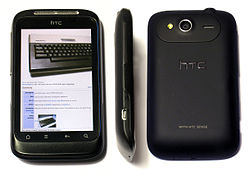 | |
| Manufacturer | HTC Corporation |
|---|---|
| Type | Smartphone |
| Availability by region | 15 February 2011 [1] |
| Predecessor | HTC Wildfire |
| Successor | HTC Explorer, HTC Desire C |
| Compatible networks |
|
| Form factor | Slate smartphone |
| Dimensions | 101.3 mm × 59.4 mm × 12.4 mm (3.99 in × 2.34 in × 0.49 in) |
| Weight | 105 g (3.7 oz) |
| Operating system | Android 2.3.3 Gingerbread (upgradable to 2.3.5) with HTC Sense 2.1.Non-official CyanogenMod ports of Android 4.0 Ice Cream Sandwich, 4.1 Jelly Bean, and 4.4.2 KitKat exist. |
| CPU | Qualcomm MSM7227 600 MHz, ARMv6 architecture |
| GPU | Adreno 200 [2] |
| Memory | 512 MB RAM |
| Storage | 512 MB (150 MB available) |
| Removable storage | microSD, up to 32 GB |
| Battery | Li-ion 1230 mAh |
| Rear camera | 5 Mpix, autofocus, LED flash, geotagging |
| Display | 3.2" 65,536 color TFT LCD HVGA (320 × 480) at 180 pixels per inch. |
| Connectivity |
|
| Data inputs | Multi-touch Capacitive touch screen. 3-axis accelerometer A-GPS Proximity sensor Light sensor Digital compass |
| Development status | Discontinued |
| Other | Facebook, Twitter , Skype , Microsoft Exchange, Google Maps turn-by-turn navigation |
The HTC Wildfire S is a smartphone developed by the HTC Corporation. The model was announced on 15 February 2011 at the Mobile World Congress [3] and released in Europe three months later.
Contents
On 14 August 2019, it was announced that the "HTC Wildfire" name had been licensed for use on the HTC Wildfire X a phone manufactured by a third-party company and intended for the Indian market. [4]
